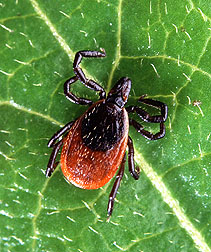This page has been archived and is being provided for reference purposes only. The page is no longer being updated, and therefore, links on the page may be invalid.
|
|
Ticks Don’t Come Out in the Wash
By Ann PerryOctober 5, 2007
Before venturing into tick-infested territory, you used a topical repellant on exposed skin and outer clothing. When you returned, you did a body check and threw your clothes in the wash. But clean clothes may not be tick-free clothes.
When he found a live lone star tick (Amblyomma americanum) on the agitator of his washing machine, Agricultural Research Service (ARS) entomologist John Carroll decided to find out how tough ticks are. So he bagged up nymphs from two species—the lone star tick and the deer tick, (Ixodes scapularis), the creature that transmits Lyme disease—and put them in the washing machine.
Carroll used a combination of water temperature settings and detergent types to wash the ticks. The majority of lone star ticks survived all the water-detergent combinations with no obvious side effects. Most of the deer ticks lived through the cold and warm water settings as well. But when one type of detergent was used with a hot water setting, only 25 percent of the deer ticks survived.
When it came time to dry, all the ticks of both species died after an hour of tumbling around at high heat. But when the dryer was set to "no heat," about one-third of the deer ticks and more than half of the lone star ticks survived.
Carroll placed the ticks in mesh bags, which kept them from draining away during the rinse cycle and perhaps increased their odds for survival. However, ticks might also survive a sudsy interlude by sheltering in the folds and crevices of a typical load of laundry. Some tick species have been observed to survive hours of submersion in fresh water.
Both adult ticks and nymphs can transmit disease. Carroll’s research reinforces recommendations by the U.S. Centers for Disease Control and Prevention to wash and dry clothes at high temperatures after spending time in areas known to harbor ticks.
Carroll conducts research at the ARS Animal Parasitic Diseases Laboratory, Beltsville, Md.
ARS is the U.S. Department of Agriculture's chief scientific research agency.

